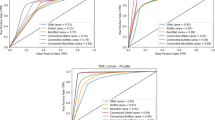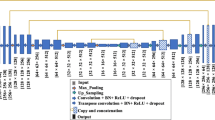Abstract
Amidst of all the tumors, breast tumor is the main source for a high incidence mortality rate among women. In the past decades, this mortality rate has tremendously reduced by early detection and diagnosis of the tumors using different modalities. Mammograms have significantly contributed towards the detection of masses and calcifications which assists radiologists in decision making. With the advent of Artificial Intelligence (AI) techniques, several breast mass segmentation methods are devised to assists radiologists in detection of tumor masses and lesions. UNet and its variants are widely used deep learning techniques for mass segmentation in mammograms. Although, UNet exhibits an outstanding performance, it has certain limitations, where the extraction of the fine-grained features is still resilient. In this paper, a AU\(^{2}\)Net is proposed where two UNets are cascaded and are connected through skip connections. The attention mechanism and Atrous Spatial Pyramid Pooling (ASPP) are introduced to learn more contextual based features for an enhanced tumor segmentation. The proposed model is validated on Curated Breast Imaging Subset of Digital Database for Screening Mammography (CBIS-DDSM). The images are preprocessed and are augmented using conventional and deep convolutional Generative Adversarial Network based approaches. The proposed method achieved a 92.3% dice score and 89.6% Intersection over Union (IoU) on CBIS-DDSM dataset.








Similar content being viewed by others
References
Sengan S, Priya V, Syed Musthafa A, Ravi L, Palani S, Subramaniyaswamy V (2020) A fuzzy based high-resolution multi-view deep cnn for breast cancer diagnosis through svm classifier on visual analysis. J Intell Fuzzy Syst 39(6):8573–8586
Dhivya S, Anjali RJ, Mohanavalli S, Sripriya N, Srinivasan K (2020) Investigations of shallow and deep learning algorithms for tumor detection. In: 2020 IEEE-HYDCON, pp 1–5. IEEE
Uthayan K, Mohanavalli S, Nivetha B, Dhivya S (2021) Optimised feature selection for early cancer detection. Genetika 53(3):1297–1309
Dhivya S, Mohanavalli S, Kavitha S (2023) Automated carcinoma classification using efficient nuclei-based patch selection and deep learning techniques. J Intell Fuzzy Syst 45(1):521–535
Ponraj DN, Jenifer ME, Poongodi P, Manoharan JS (2011) A survey on the preprocessing techniques of mammogram for the detection of breast cancer. J Emerg Trends Comput Inf Sci 2(12):656–664
LeCun Y, Bengio Y (2015) Deep learning. Nature 521(7553):436–444
Li X, Jiang Y, Liu Y, Zhang J, Yin S, Luo H (2022) Ragcn: region aggregation graph convolutional network for bone age assessment from x-ray images. IEEE Trans Instrum Meas 71:1–12. https://doi.org/10.1109/TIM.2022.3190025
Li X, Lv S, Li M, Zhang J, Jiang Y, Qin Y, Luo H, Yin S (2023) Sdmt: Spatial dependence multi-task transformer network for 3d knee MRI segmentation and landmark localization. IEEE Trans Med Imag
Ren Z, Wang S, Zhang Y (2023) Weakly supervised machine learning. CAAI Trans Intell Technol. https://doi.org/10.1049/cit2.12216
Zhang Y, Deng L, Zhu H, Wang W, Ren Z, Zhou Q, Lu S, Sun S, Zhu Z, Gorriz JM, Wang S (2023) Deep learning in food category recognition. Inf Fusion 98:101859. https://doi.org/10.1016/j.inffus.2023.101859
Ren Z, Zhang Y, Wang S (2022) A hybrid framework for lung cancer classification. Electronics 11(10):1614
Dhivya S, Mohanavalli S, Karthika S, Shivani S, Mageswari R (2020) Gan based data augmentation for enhanced tumor classification. In: 2020 4th international conference on computer, communication and signal processing (ICCCSP), pp 1–5. IEEE
Simonyan K, Zisserman A (2014) Very deep convolutional networks for large-scale image recognition. arXiv preprint arXiv:1409.1556
Szegedy C, Liu W, Jia Y, Sermanet P, Reed S, Anguelov D, Erhan D, Vanhoucke V, Rabinovich A (2015) Going deeper with convolutions. In: Proceedings of the IEEE conference on computer vision and pattern recognition, pp 1–9
He K, Zhang X, Ren S, Sun J (2016) Deep residual learning for image recognition. In: Proceedings of the IEEE conference on computer vision and pattern recognition, pp 770–778
Long J, Shelhamer E, Darrell T (2015) Fully convolutional networks for semantic segmentation. In: Proceedings of the IEEE conference on computer vision and pattern recognition, pp 3431–3440
Badrinarayanan V, Kendall A, Cipolla R (2017) Segnet: a deep convolutional encoder-decoder architecture for image segmentation. IEEE Trans Pattern Anal Mach Intell 39(12):2481–2495
Ronneberger O, Fischer P, Brox T (2015) U-net: convolutional networks for biomedical image segmentation. In: Proceedings of 18th international conference medical image computing and computer-assisted intervention–MICCAI 2015, Munich, Germany, October 5-9, 2015, Part III 18, pp 234–241. Springer
Kadia DD, Alom MZ, Burada R, Nguyen TV, Asari VKR (2021) 2 u3d: recurrent residual 3d u-net for lung segmentation. IEEE Access 9:88835–88843
Huang H, Lin L, Tong R, Hu H, Zhang Q, Iwamoto Y, Han X, Chen Y.-W, Wu J (2020) Unet 3+: a full-scale connected unet for medical image segmentation. In: ICASSP 2020-2020 IEEE international conference on acoustics, speech and signal processing (ICASSP), pp 1055–1059. IEEE
Zhang J, Jin Y, Xu J, Xu X, Zhang Y (2018) Mdu-net: multi-scale densely connected u-net for biomedical image segmentation. arXiv preprint arXiv:1812.00352
Huang G, Liu Z, Van Der Maaten L, Weinberger KQ (2017) Densely connected convolutional networks. In: Proceedings of the IEEE conference on computer vision and pattern recognition, pp 4700–4708
Zhou S, Nie D, Adeli E, Yin J, Lian J, Shen D (2019) High-resolution encoder-decoder networks for low-contrast medical image segmentation. IEEE Trans Image Process 29:461–475
Chen L-C, Papandreou G, Kokkinos I, Murphy K, Yuille AL (2017) Deeplab: semantic image segmentation with deep convolutional nets, atrous convolution, and fully connected CRFS. IEEE Trans Pattern Anal Mach Intell 40(4):834–848
Dong H, Yang G, Liu F, Mo Y, Guo Y (2017) Automatic brain tumor detection and segmentation using u-net based fully convolutional networks. In: Valdés Hernández M, González-Castro V (eds) Medical image understanding analysis. Springer, Cham, pp 506–517
Zhu W, Xiang X, Tran TD, Hager GD, Xie X (2018) Adversarial deep structured nets for mass segmentation from mammograms. In: 2018 IEEE 15th international symposium on biomedical imaging (ISBI 2018), pp 847–850. IEEE
Sun K, Xin Y, Ma Y, Lou M, Qi Y, Zhu J (2022) Asu-net: U-shape adaptive scale network for mass segmentation in mammograms. J Intell Fuzzy Syst 42(4):4205–4220
Sathyan A, Martis D, Cohen K (2020) Mass and calcification detection from digital mammograms using unets. In: 2020 7th international conference on soft computing & machine intelligence (ISCMI), pp 229–232. IEEE
Sun H, Li C, Liu B, Liu Z, Wang M, Zheng H, Feng DD, Wang S (2020) Aunet: attention-guided dense-upsampling networks for breast mass segmentation in whole mammograms. Phys Med Biol 65(5):055005
Lai X, Yang W, Li R, et al (2020) Dbt masses automatic segmentation using u-net neural networks. Comput Math Methods Med
Pi J, Qi Y, Lou M, Li X, Wang Y, Xu C, Ma Y (2021) Fs-unet: mass segmentation in mammograms using an encoder-decoder architecture with feature strengthening. Comput Biol Med 137:104800
Cao H, Pu S, Tan W (2021) A novel method for segmentation of breast masses based on mammography images. In: 2021 IEEE international conference on image processing (ICIP), pp 3782–3786. IEEE
Zhuang Z, Li N, Joseph Raj AN, Mahesh VG, Qiu S (2019) An rdau-net model for lesion segmentation in breast ultrasound images. PLoS ONE 14(8):0221535
Rajalakshmi NR, Vidhyapriya R, Elango N, Ramesh N (2021) Deeply supervised u-net for mass segmentation in digital mammograms. Int J Imaging Syst Technol 31(1):59–71
Soulami KB, Kaabouch N, Saidi MN, Tamtaoui A (2021) Breast cancer: One-stage automated detection, segmentation, and classification of digital mammograms using unet model based-semantic segmentation. Biomed Signal Process Control 66:102481
Abdelhafiz D, Nabavi S, Ammar R, Yang C, Bi J (2019) Residual deep learning system for mass segmentation and classification in mammography. In: Proceedings of the 10th ACM international conference on bioinformatics, computational biology and health informatics, pp. 475–484
Abdelhafiz D, Bi J, Ammar R, Yang C, Nabavi S (2020) Convolutional neural network for automated mass segmentation in mammography. BMC Bioinform 21(1):1–19
Oktay O, Schlemper J, Folgoc LL, Lee M, Heinrich M, Misawa K, Mori K, McDonagh S, Hammerla NY, Kainz B, et al (2018) Attention u-net: Learning where to look for the pancreas. arXiv preprint arXiv:1804.03999
Vakanski A, Xian M, Freer PE (2020) Attention-enriched deep learning model for breast tumor segmentation in ultrasound images. Ultrasound Med Biol 46(10):2819–2833
Lou M, Qi Y, Li X, Xu C, Zhao W, Deng X (2022) Aggregated pyramid attention network for mass segmentation in mammograms. Multimed Tools Appl 81(10):13335–13353
Hai J, Qiao K, Chen J, Tan H, Xu J, Zeng L, Shi D, Yan B, et al (2019) Fully convolutional densenet with multiscale context for automated breast tumor segmentation. J Healthcare Eng
Xu C, Qi Y, Wang Y, Lou M, Pi J (2022) Arf-net: an adaptive receptive field network for breast mass segmentation in whole mammograms and ultrasound images. Biomed Signal Process Control 71:103178
Li S, Dong M, Du G, Mu X (2019) Attention dense-u-net for automatic breast mass segmentation in digital mammogram. IEEE Access 7:59037–59047. https://doi.org/10.1109/ACCESS.2019.2914873
Chen L, Bentley P, Mori K, Misawa K, Fujiwara M (2018) Drinet for medical image segmentation. IEEE Trans Med Imaging 37(11):2453–2462. https://doi.org/10.1109/TMI.2018.2835303
Murugesan M, Kaliannan K, Balraj S, Singaram K, Kaliannan T, Albert JR (2022) A hybrid deep learning model for effective segmentation and classification of lung nodules from ct images. J Intell Fuzzy Syst 42(3):2667–2670
Zhang Y, Deng L, Zhu H, Wang W, Ren Z, Zhou Q, Lu S, Sun S, Zhu Z, Gorriz JM, et al (2023) Deep learning in food category recognition. Inf Fusion 101859
Zhou Z, Siddiquee MMR, Tajbakhsh N, Liang J (2019) Unet++: redesigning skip connections to exploit multiscale features in image segmentation. IEEE Trans Med Imag 39(6):1856–1867
Author information
Authors and Affiliations
Contributions
All authors equally contributed to this research work. All authors have read and agreed to the published version of the manuscript.
Corresponding author
Ethics declarations
Conflicts of interest
The authors declare no conflict of interest.
Additional information
Publisher's Note
Springer Nature remains neutral with regard to jurisdictional claims in published maps and institutional affiliations.
Rights and permissions
Springer Nature or its licensor (e.g. a society or other partner) holds exclusive rights to this article under a publishing agreement with the author(s) or other rightsholder(s); author self-archiving of the accepted manuscript version of this article is solely governed by the terms of such publishing agreement and applicable law.
About this article
Cite this article
Dhivya, S., Mohanavalli, S., Sundharakumar, K.B. et al. Attention \(U^2Net\): Cascaded UNets with Modified Skip Connection for Breast Tumor Segmentation. Neural Process Lett 55, 11863–11883 (2023). https://doi.org/10.1007/s11063-023-11400-3
Accepted:
Published:
Issue Date:
DOI: https://doi.org/10.1007/s11063-023-11400-3




